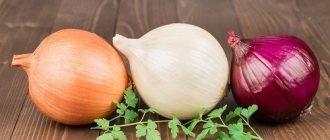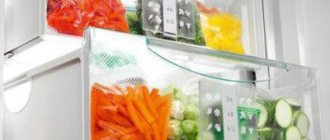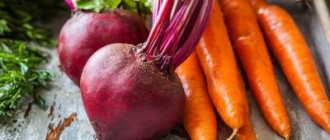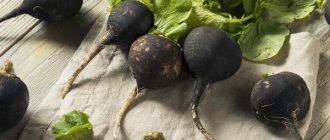We invite you to familiarize yourself with some of our recommendations on how to properly store carrots in winter. Autumn is the period of harvesting and housewives are faced with an acute question: how to preserve root crops for the winter? One of the most finicky vegetables in terms of storage is carrots. It rots in high humidity and withers in heat, and bacteria and fungus easily penetrate through the thin skin. Improper storage also leads to loss of taste and nutrients, which the root vegetable is so rich in.
To preserve carrots until spring, plant varieties that are suitable for long-term storage, collect and dry the crop in a timely manner, and also create a favorable microclimate for saving
Harvesting and preparing it for storage
The success of preserving the root crop and its beneficial properties depends on the carrot variety, growing conditions and region, and harvest time . Root crops are harvested in September, 90-120 days after planting.
You should dig up the root crop with a pitchfork or garden shovel . When tearing out the vegetable by the tops, make sure that the fruit does not break.
When digging, avoid mechanical damage to root crops. Carrots with scratches, cuts or breaks cannot be stored for long periods of time.
Harvest carrots in dry weather. When digging, be careful not to damage the skin or tear off the tops
It is important to know that harvesting should be carried out in dry weather . This will completely dry the vegetables and prevent large-scale rotting. To dry, place the root vegetables on a wooden surface under a canopy (on the veranda, loggia, in the garage) or outside (subject to good weather). An important condition for drying is constant circulation of fresh air and minimal humidity. The duration of drying depends on the initial state of the root crops, but on average it is 2-5 days.
To dry carrots, place them on straw in the fresh air. Make sure that the vegetables are not exposed to direct sunlight during drying and that they do not heat up.
Peculiarities
The method depends on the type of carrot: fresh or cooked, whether it is washed, and for what purpose it will be used. A modern refrigerator is suitable for most of the above cases, since it has different compartments and knows at what temperature it is worth storing food:
- for cooked products at +2–6°C;
- fresh fruits and vegetables with a temperature of +0–3°C;
- for freezing at -8–20°C.
If you place the root crop in the right compartment, this will ensure its best storage and maximum retention of nutrients.
Selection of root crops for storage
Before storing vegetables, they must be sorted and prepared. Dried carrots need to be cleaned of soil and dirt . To do this, gently wipe it with gloved hands. Do not knock vegetables on the ground or throw them to avoid damage.
Carefully sort through the entire harvest . Vegetables with signs of spoilage (dark spots, soft spout or spine) and damaged (with cuts, scratches or breaks) are subject to rejection. Remember, even one spoiled root crop can lead to infection and destruction of the entire crop.
For storage, choose firm, mature and healthy carrots of suitable varieties.
The best preserved are “Moscow Winter”, “Nantes 4”, “Chantane”, “Nigel”, “Samson”, “Cascade”, “Vitamin 6”. Varieties such as “Parizhskaya Karotel” and “Amsterdamskaya” are not subject to long-term storage.
For storage, select only whole, healthy and firm fruits. Before planting, carefully inspect each root crop and discard vegetables that are damaged or rotting.
Having selected vegetables that are unsuitable for storage, sort the rest by size. It is recommended to use small carrots first, then medium ones and then large ones. This requirement is due to the fact that large root crops are stored better and longer.
After sorting, carrot tops sent for storage must be cut with a knife or scissors. Leave a tail of 2-3 cm.
How to choose a vegetable?
Which carrot is better to choose for long-term storage:
- The fruits must be sufficiently ripe.
- No signs of rot, no damage or disease.
- The coarser the carrots, the longer they last.
- Well dried, without excess moisture.
- The right variety.
- It is better to exclude small fruits; they are more susceptible to wilting.
Reference! It is also worth paying attention to harvesting; it is not advisable to dig up carrots in wet, rainy weather, otherwise it will be difficult to dry them.
Optimal storage conditions and periods
To preserve carrots, it is necessary to create a favorable microclimate for them. The optimal temperature is −1…+1 ℃, and humidity is 90-95%. The ideal place that meets all requirements is the cellar .
For ease of perception, we summarize the information about the storage times and places of carrots in a table:
| Storage method | Storage time |
| In the cellar (in liquid clay, pine sawdust, onion peels, chalk) | Up to 12-14 months |
| In the cellar (closed boxes or sand) | Up to 8 months |
| In the cellar (plastic bag) | Up to 4 months |
| At home in the refrigerator, vegetable compartment | Up to 2 months |
| At home in the freezer | Up to 12 months |
To extend the shelf life of carrots, do not place them near apples. Fruits emit ethylene, which leads to rapid spoilage of root vegetables.
Regular inspection of the workpiece will help increase the storage duration . View all products, remove spoiled root crops and cut off sprouted tops.
The best place
Where is the best place to store carrots? Before the onset of the first cold weather, the harvest is well stored on the balcony.
It is very important to carefully monitor temperature fluctuations, and, as soon as frost occurs , remove the crops indoors.
In this case, the container with vegetables can be placed next to the balcony door , where the temperature is lower compared to the entire apartment.
Root vegetables are best stored in an apartment pantry or in the basement of a house , where the temperature and humidity are suitable. This is usually done in bulk: carrots are scattered on a spread surface. Or in boxes made of corrugated cardboard or wood.
Note! It is best to store carrots in a dark, cool place, away from heating appliances and radiators .
Where is the best place to store it in an apartment? The best place to store root vegetables in an apartment is a dark, cool place, such as a pantry. Many housewives prefer to leave vegetables in the kitchen, but it is better not to do this; during cooking, the temperature in this room increases , which has a bad effect on the preservation of root vegetables.
It is best to immerse vegetables in a specially prepared box or bag. Lay out the fruits in a dense layer, and place horseradish rhizome .
Horseradish has bactericidal properties that prevent the formation of mold and mildew .
You will learn how to store carrots with horseradish without a basement from the video:
Storage methods
Basement and cellar
The ideal place to store carrots is a basement or cellar. In such rooms, optimal temperature and humidity are maintained, which allows you to preserve vegetables until the next harvest. With proper storage, you can enjoy tasty and juicy fruits rich in vitamins and minerals all year round.
Before storing carrots, prepare the room: remove all last year's preparations, sweep well, ventilate and dry the cellar. If necessary, insulate it and waterproof it.
Take care of air ventilation, which should be of medium intensity. If there is an excess of air, the carrots will begin to sprout, and if there is not enough air, they will wither.
A simple and good method is wooden boxes with a lid . To create the blank, prepare containers. The boxes must be absolutely dry and tight. Place root vegetables in prepared containers in several rows, but not more than 20 kg. Close the box with a lid and place it in the cellar at a distance of 10-15 cm from the wall - this will protect the fruits from dampness and accumulated condensation. If possible, place containers on small stands. This method allows you to compactly place a large amount of product even in limited space. The carrots will remain fresh and will not rot, sprout or wither.
The optimal container for storage is wooden boxes. They are convenient and ergonomic to use, and also contribute to the long-term preservation of carrots
To store carrots, you can use sawdust from coniferous trees . Place the root vegetables in a box, layering them with shredded wood. Sawdust releases phenolic substances that protect the crop from diseases and rotting.
If after harvesting onions for the winter there are husks , use them to store carrots. Place the raw materials in bags (boxes) and place the root vegetables there. The husk will absorb excess moisture, protecting vegetables from rotting and sprouting. In addition, the released phytoncides will prevent the proliferation of bacteria and minimize the risk of developing diseases. Place the prepared container on a small hill in the basement or cellar.
Another way to store vegetables in the cellar is to mix chalk and cleaned wet sand . Pour the mixture into the box, place the carrots with the thick end up, and add another layer on top. The advantages of this method: chalk prevents the growth of bacteria, and wet sand preserves the freshness and taste of vegetables for a long time.
You can also use sand when placing carrots in a wooden box. Sprinkle each row well and cover the root vegetables with a layer of wet sand.
An interesting way to store carrots in the form of a pyramid . The sequence of creating a blank is quite simple. Place a thick layer of sand on the bottom of a drawer or shelf. It is important that it is barely damp, but not wet. Place a row of carrots and cover with the next layer of sand. Then lay the fruits again, but in a checkerboard pattern in relation to the first row. Repeat the steps several times, but make sure that the height of the pyramid does not exceed 1 m.
The river sand that will be used for storing carrots must first be sieved and calcined to destroy pathogenic microorganisms.
You can store carrots in a chalk solution :
- Mix chalk with water until you obtain a homogeneous mixture, the consistency of liquid sour cream.
- Soak each root vegetable in the solution and dry well.
- Place the carrots in wooden boxes or simply place them at the bottom of the basement.
An unusual way to store carrots is in a clay solution . The clay shell will protect the carrots from spoilage and rotting. Before storing root vegetables, dip each vegetable in a clay solution and dry. The clay should completely cover the carrots. Once completely dry, place the fruits in a basket or box and place them in a cool, damp place.
A clay solution will help extend the shelf life of carrots. Soak the entire crop in it, and then dry each carrot separately until the clay completely hardens.
Clay mortar can also be used for pouring. To do this, fill 1/2 a bucket of clay with water and leave for a day. Then mix everything well and add a little more liquid. The finished clay should have a consistency similar to liquid sour cream.
After preparing the mixture, prepare the container: cover the bottom of the box or bucket with plastic wrap. Then place a layer of carrots so that the roots do not touch each other. Fill everything with clay and let it dry slightly, and then start laying out a new layer. Repeat until the entire container is filled.
For those who don’t want to bother with boxes and sand, another common method for storing carrots is suitable - in plastic bags . Place the root vegetables in plastic bags and place them at the bottom of the cellar. Make such packages small so that they hold no more than 2-2.5 kg of root vegetables each. Then, with regular checking, you will be able to promptly remove the package in which the carrots have begun to deteriorate, and in the remaining packages the product will remain intact.
Be sure to make several holes in the bags that will serve for ventilation and condensation removal. In this form, the carrots do not dry out or wither. The shelf life of such products cannot exceed 4 months.
You can store carrots in plastic bags in the cellar, but be prepared for the fact that such a crop will not last long
Fridge
If you don’t have a cellar or basement, you can store carrots at home in the refrigerator. To do this, place the dried fruits in plastic bags and place them in a vegetable drawer. The shelf life of carrots in this form is quite short - no longer than 2 months.
You can store carrots in the refrigerator. Use the vegetable compartment (and remember that after 1.5-2 months it will start to spoil)
Freezer
You can store carrots in the freezer for 12-14 months. For freezing, choose juicy and firm fruits. Dry and limp ones are not suitable for this purpose.
You can freeze carrots whole . Wash the vegetables well, cut off the tops and peel off the outer skin. Place the products in freezer bags and place them in the freezer.
You can also pre -grind on a grater, in a food processor, and cut them into cubes or strips. Place the prepared raw materials in small containers, zip-lock bags or regular plastic bags. (This storage option will save time during cooking.)
You can store carrots in the freezer in a ziplock bag, plastic container, or vacuum sealer.
Drying carrots
Carrots that are considered unsuitable for fresh storage (damaged, having an “irregular” shape, small, etc.) can be dried. To do this you need:
- rinse the root vegetables, peel them, remove blemishes;
- Blanch the carrots in boiling water for 10-15 minutes;
- grind according to future uses. You can cut the root vegetables into circles or cubes, grate them on a coarse grater or use a shredder.
The processing method is chosen depending on the capabilities and desires of a particular housewife. Carrots can be easily dried in the oven , microwave or electric dryer .
Air-solar drying, which our grandmothers often used, requires much more effort and takes quite a long time (usually about 2 weeks). But in this case the product is of very high quality. Carrots dried “naturally” can not only be included in a wide variety of dishes. It fully preserves the beneficial properties of fresh vegetables and is used to brew healing tea, which has an extremely beneficial effect on the human body.
Dried carrots are stored in any container (glass or tin jars, fabric bags, etc.) that well protects the contents from moisture and the penetration of household pests. In this form, the product does not lose its consumer properties for 1 year
In an apartment, you can store root vegetables on the balcony, in the underground or in the pantry. The main thing is that the temperature and humidity conditions meet the requirements.
Some tips
Over the years, gardeners and housewives have developed their own tricks, including those related to harvest storage. We decided to share some subtleties:
- When harvesting, it is better to trim the tops within an hour: they draw moisture from the carrots and they wither faster.
- You can’t wash carrots, as they won’t store as well this way. By the way, for this reason, it is not advisable to buy washed carrots in supermarkets, especially those packaged in large bags.
- There is no need to store different varieties in one bag or in one box: the shelf life of such carrots is different, some will begin to deteriorate faster and “infect” healthy ones with rot.
- According to statistics, long cone-shaped carrots are best stored, not too small, but not large either.
- Instead of sand, carrots can be covered with moss. It draws moisture well and prevents root crops from rotting.
You can also leave the carrots in the ground, covering the top of the bed with sand in a layer of up to 10 cm. Instead of sand, you can use fallen leaves, and cover everything on top with plastic film so that the insulation does not blow away in the wind. True, in winter some rodent may take a fancy to the garden bed, so the method is not the most reliable and can only be used as a last resort.
Which varieties can be kept fresh for a long time?
For long-term preservation of these vegetables, late-ripening varieties are best suited.
Among the middle categories there are also varieties of carrots that are subject to long-term storage, but many of them, as a rule, do not have any taste.
Late-ripening categories include those that ripen 115-135 days after the appearance of seedlings. These varieties are cold-resistant, not so susceptible to diseases, and therefore their preservation is better.
Under favorable conditions, late-ripening carrots are stored until July, and do not lose their taste. Typically, these categories of vegetables have oblong, pointed shapes. The most popular and in demand are the following varieties of carrots:
Queen of Autumn
An excellent category from Altai breeders, it’s not for nothing that they called it that.
Root crops grown on fertile soil, as a rule, exceed traditional characteristics, since the yield is about 9 kg/m2, weight – 240 g, and length – 25 cm.
Dolyanka
Representative from Polish breeders, preserves well until June . If the soil is infested with carrot fly larvae, this variety would be a good choice for the next planting. The fruits are medium, weight - from 140 g.
Flaccoro
It attracts the attention of gardeners with its productivity (from 8.5 kg/m2), has long root crops up to 27 cm and weighs about 200 grams.
Mid-season varieties for long-term storage include:
Moscow winter
High-yielding category, can retain its qualities for up to 10 months .
Shantanay
Despite the average ripeness, the fruits have a sweet taste and can be stored well for 8-10 months.
Why does it wither, turn black, rot?
When storing carrots, they should be sorted and sorted whenever possible. Very often, vegetables lose too much moisture when lying around.
This is due to the thin layer of skin on the root vegetables. As a result, the carrots wither, lose their hardness and presentation. The mass also decreases.
If black rot is noticed on root crops, then proceed as follows:
- Remove damaged vegetables.
- Treat (spray with a sprayer) the area that was the source of rot infection with fluff lime.
Pre-treatment of the crop can prevent spoilage of carrots. One option is treatment with a solution of potassium permanganate.
Storing a large number of root vegetables in one container can provoke the development of a disease - white rot . Transmitted from fruit to fruit, the disease can spoil a large mass of root crops.
Prevention of infection of carrots with white rot is to soak them in a solution of potassium permanganate for a couple of hours. After this, the vegetables are dried. Treatment with potassium permanganate will not help prevent infection with black rot.
Something went wrong
The worst thing that can happen to a vegetable is spoilage. Most often, there is only one reason why carrots rot during storage, turn black, sprout or become soft - this is improper storage. It can be caused either by improper operation of the refrigerator or freezer, or by the carelessness of the owners.
Once every one to two weeks, carrots should be inspected for droplets inside the package. Their occurrence indicates the presence of carbon dioxide - in this case, the root crop must be removed, dried and packaged again. Most often, this problem occurs only in the refrigerator, but it can also happen with the freezer if it malfunctions.
Natural carrot juice
Carrot juice, which is obtained by squeezing fresh vegetables, is a very healthy drink with a high carotene content . This is a perishable product that is not intended for storage without additional processing.
In order for vegetable juice to bring only benefits, it is advisable to drink it immediately. The unfinished remainder can sit in the refrigerator for several hours. But it should be taken into account. That there are fewer and fewer useful substances in it literally every minute.
You can find out how long carrot juice can be stored here.
Planting seeds for the winter
When purchasing carrot seeds, you should keep in mind that the germination period for these vegetables is 2-3 years . In this case, seedlings appear 10-12 days after planting the seeds. You also need to take into account that the longer the shelf life, the lower the germination rate of such seeds. To speed up the germination process of seeds, it is recommended to soak them in a nutrient liquid.
On a note! According to experienced gardeners, it is safest to use carrot seeds from the previous harvest.
There is also a method of winter sowing, when at the end of November the furrows are deepened by 5 centimeters, and the top is “insulated” with humus. In this case, the number of seeds must be increased by 20-30%. This trick will allow you to get fresh root vegetables at the end of June. The winter carrot crop is not intended for long-term storage .
In Korean
Carrots cooked in Korean are grated fresh vegetables to which spices and hot vegetable oil are added. This dish contains no perishable ingredients.
The preparation technology requires that the salad “infuse” for 24 hours in the cold . After this, the duration of the product's stay in an airtight plastic container or in a glass jar under a lid in the refrigerator.
You can learn about storing carrots in Korean here.











